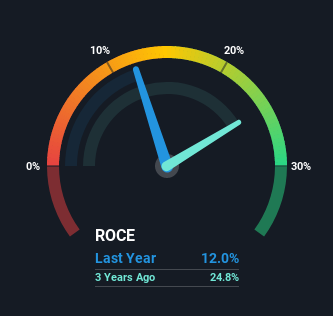- India
- /
- Auto Components
- /
- NSEI:STERTOOLS
Sterling Tools (NSE:STERTOOLS) Might Be Having Difficulty Using Its Capital Effectively
There are a few key trends to look for if we want to identify the next multi-bagger. Amongst other things, we'll want to see two things; firstly, a growing return on capital employed (ROCE) and secondly, an expansion in the company's amount of capital employed. Basically this means that a company has profitable initiatives that it can continue to reinvest in, which is a trait of a compounding machine. Having said that, from a first glance at Sterling Tools (NSE:STERTOOLS) we aren't jumping out of our chairs at how returns are trending, but let's have a deeper look.
Understanding Return On Capital Employed (ROCE)
For those that aren't sure what ROCE is, it measures the amount of pre-tax profits a company can generate from the capital employed in its business. Analysts use this formula to calculate it for Sterling Tools:
Return on Capital Employed = Earnings Before Interest and Tax (EBIT) ÷ (Total Assets - Current Liabilities)
0.12 = ₹489m ÷ (₹5.2b - ₹1.1b) (Based on the trailing twelve months to June 2021).
So, Sterling Tools has an ROCE of 12%. That's a relatively normal return on capital, and it's around the 14% generated by the Auto Components industry.
View our latest analysis for Sterling Tools

While the past is not representative of the future, it can be helpful to know how a company has performed historically, which is why we have this chart above. If you're interested in investigating Sterling Tools' past further, check out this free graph of past earnings, revenue and cash flow.
So How Is Sterling Tools' ROCE Trending?
When we looked at the ROCE trend at Sterling Tools, we didn't gain much confidence. To be more specific, ROCE has fallen from 32% over the last five years. Although, given both revenue and the amount of assets employed in the business have increased, it could suggest the company is investing in growth, and the extra capital has led to a short-term reduction in ROCE. And if the increased capital generates additional returns, the business, and thus shareholders, will benefit in the long run.
On a related note, Sterling Tools has decreased its current liabilities to 21% of total assets. So we could link some of this to the decrease in ROCE. What's more, this can reduce some aspects of risk to the business because now the company's suppliers or short-term creditors are funding less of its operations. Some would claim this reduces the business' efficiency at generating ROCE since it is now funding more of the operations with its own money.
The Bottom Line On Sterling Tools' ROCE
While returns have fallen for Sterling Tools in recent times, we're encouraged to see that sales are growing and that the business is reinvesting in its operations. In light of this, the stock has only gained 32% over the last five years. Therefore we'd recommend looking further into this stock to confirm if it has the makings of a good investment.
Since virtually every company faces some risks, it's worth knowing what they are, and we've spotted 2 warning signs for Sterling Tools (of which 1 makes us a bit uncomfortable!) that you should know about.
If you want to search for solid companies with great earnings, check out this free list of companies with good balance sheets and impressive returns on equity.
New: Manage All Your Stock Portfolios in One Place
We've created the ultimate portfolio companion for stock investors, and it's free.
• Connect an unlimited number of Portfolios and see your total in one currency
• Be alerted to new Warning Signs or Risks via email or mobile
• Track the Fair Value of your stocks
This article by Simply Wall St is general in nature. We provide commentary based on historical data and analyst forecasts only using an unbiased methodology and our articles are not intended to be financial advice. It does not constitute a recommendation to buy or sell any stock, and does not take account of your objectives, or your financial situation. We aim to bring you long-term focused analysis driven by fundamental data. Note that our analysis may not factor in the latest price-sensitive company announcements or qualitative material. Simply Wall St has no position in any stocks mentioned.
Have feedback on this article? Concerned about the content? Get in touch with us directly. Alternatively, email editorial-team (at) simplywallst.com.
About NSEI:STERTOOLS
Sterling Tools
Manufactures and sells high tensile cold forged fasteners to original equipment manufacturers in India.
Excellent balance sheet average dividend payer.
Similar Companies
Market Insights
Community Narratives


